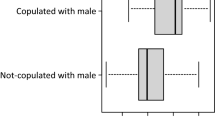Summary.
The female of the cockroach, Diploptera punctata, mates immediately after the last molt, when she is still teneral. In this condition, her quinone-producing defensive glands are empty and she is potentially vulnerable to predation. By mating with fully sclerotized males whose glands are functional, she may benefit, indirectly, from the protection provided by the male's own glandular discharges. However, while males do indeed eject their defensive spray when disturbed while mating, and as a rule tend to remain coupled to the female when disturbed, they spray only when they themselves are the target of the offense. Copulating males do not activate their defenses in response to disturbance of the female.
Similar content being viewed by others
Author information
Authors and Affiliations
Additional information
Received 11 August 2000; accepted 29 September 2000
Rights and permissions
About this article
Cite this article
Wyttenbach, R., Eisner, T. Use of defensive glands during mating in a cockroach (Diploptera punctata). Chemoecology 11, 25–28 (2001). https://doi.org/10.1007/PL00001828
Issue Date:
DOI: https://doi.org/10.1007/PL00001828




